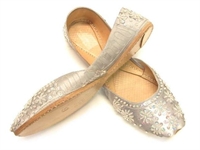
Shoes of the World
Important Notice: Our web hosting provider recently started charging us for additional visits, which was unexpected. In response, we're seeking donations. Depending on the situation, we may explore different monetization options for our Community and Expert Contributors. It's crucial to provide more returns for their expertise and offer more Expert Validated Answers or AI Validated Answers. Learn more about our hosting issue here.
Fashion knows no boundaries. Every year as seasons change, consumers are faced with fashion-forward, shockingly expensive and often ridiculously "unwearable" designs that most women end up buying anyway due to one reason: Popularity leading to mass production.
But imagine yourself breaking away from the chains of popular culture and going for something unique, authentic and otherwise cultural fashion-wise, which country would you wear? Considering the influx of ethnic designs fused with the modernism of this year’s trends, it only seems fair to get to know where the fashion items we love so much originated from.
A Look at Cultural Icons in Footwear
Geta and Zori Sandals (Japan) Otherwise known as the geisha clogs, geta is flip flops and clogs in one. Designed to wear with the traditional kimonos, geta sandals are wooden thongs elevated to keep the geisha’s feet dry from walking in rain or snow. It is easy to tell what type of geta pair to buy. For women, they are curvy around the edges and men wear the square ones. Zori, on the other hand, are flat-bottomed sandals in straw or vinyl materials, less formal than the geta and are often worn inside the house.
Geta Sandals in 2010. Thesedays, many women wear geta clogs as fashion item every since it got modernized. Printed and flowery fabrics in attractive colors while maintaining its original wooden sole form exude beauty in springtime all the way to summer. Geta sandals are sold from $20-40 US depending on style and quality. They can be purchased from many Japanese online shops and some can be found on ebay, check out MZK Studio.
Danish Clogs (Denmark) What moms used to wear back in the 70’s are now totally in! The traditional clogs of Denmark and Netherlands were used by workers of fields as protection to their feet. Danish clogs were originally made of all wood: wooden soles and wooden uppers. They were big and unattractive, not to mention heavy. For safety reasons, women and men wore clogs until they were worn to clog dances or "clogging". These days, a visit to Denmark means grabbing a pair of Danish clogs for personal collection or souvenirs. They are handpainted, still huge but definitely cool.
Danish Clogs in 2010. The original handpainted Danish clogs of today by The Swanks are vivid in colors, with paintings that express wild imaginations. Sanita Clogs have managed to keep Danish clogs in existence by incorporating the original with something cute such as ribbons and studs that women can live by no matter what age. After Chanel launched the Spring/Summer 2010 collection featuring modern clogs, the wooden footwear have been making a big comeback (I even bought a pair). Visit vogue.com for more on Chanel’s Ready-to-Wear fashion show.
Khussa Shoes (India) Bollywood and the spread of belly dancing as recreation brought beaded khussa flats into fashion exposure. The footwear is rich in color, comfortable and eye-catching with the generous use of intricate beading, sequins and embroidered threadwork. For centuries, Indian women have worn khussa on weddings and special days celebrations.
Khussa Shoes in 2010. These pretty flat shoes have become the inspiration of the widely popular beaded and studded footwear of today that many designers incorporated in their latest creations. Young women find the colors and beadworks attractive, hip and fabulously unique. Many wear the pairs with jeans and skirts when they feel like going for the Boho Chic look. Beachcombersbazaar.com has an online catalog with the latest colors and styles of Khussa heels, flats as well as Chappals (Ethnic Indian thong sandals). – MR
Keep reading May Rogers Shoe column for part 2 of SHOES OF THE WORLD
Contact: info.mayrogers@yahoo.com